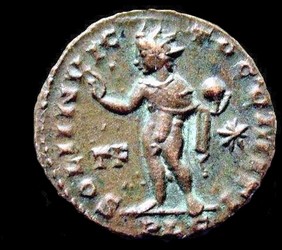Sol Roman worship of the sun-god Sol, was very popular from the first century BC to the fourth century AD. Roman Sol had shrines on the Quirinal and in the Circus Maximus and was sometimes associated with both the Greek sun-god Helios, and the Indo-Iranian sun-god Mithras. The cult of Mithras in particular became very popular among soldiers. Sol Invictus (the unconquered sun) appears on Roman coins from the reign of Septimius Severus onwards and gained prominence under Elagabalus. In AD 274, during the reign of Aurelian, the cult of Sol was officially recognised. Images of Sol appear frequently as reverse type during the third and fourth centuries until the reign of Constantine the Great. The sun-god is usually depicted nude; wearing a radiate crown; a chlamys draped over one shoulder; holding a whip or globe; sometimes he drives a chariot. On an antoninianus of Gallienus (top right) the legend on the reverse, Sol Oriens, refers to the sun rising in the east and alludes to the prosperity of the reigning emperor, who is usually depicted on the obverse wearing a radiate crown. According to the legend SOLI INVICTO COMITI which adorns the majority of these coin types, Sol is also the invincible companion of the current emperor, as depicted on the bronze (right) of Constantine the Great. From 310 AD on Constantine used Sol on his coinage and claimed the divine protection of this deity, who, as Apollo-Sol, appeared to him in a vision. For the time being, Contantine continued to use pagan imagery on his coinage, thus accommodating the tetrarchic system which included pagan rulers like Licinius. However, the image of Sol on reverse coin types of Constantine appears to be a slightly subdued version of the pagan god and eventually, after his conversion to Christianity, disappeared from his coinage in 318 AD. |  |